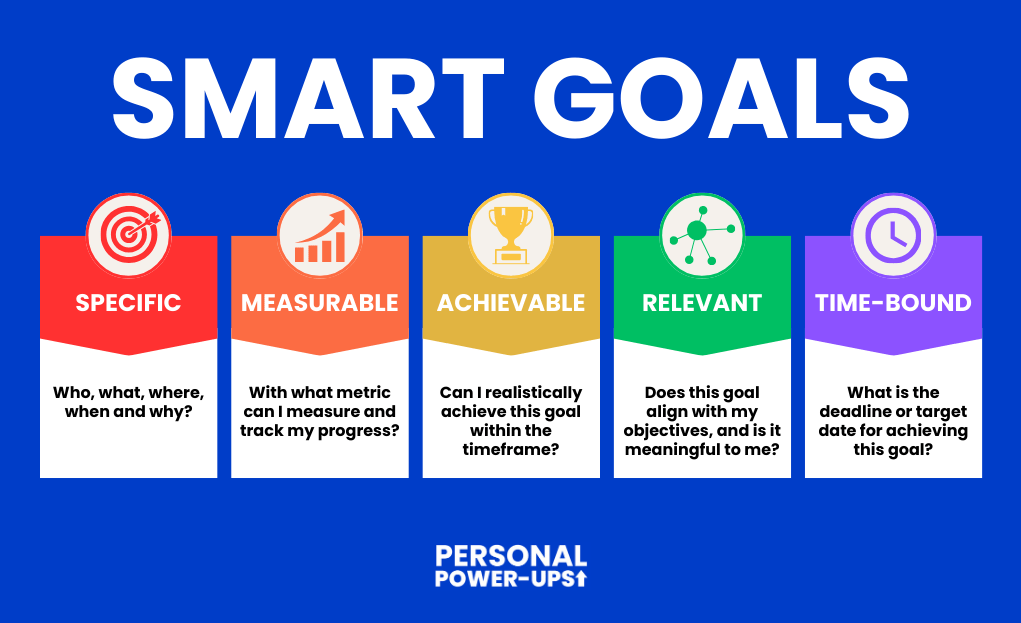Setting goals is an important part of your personal and professional growth. However, just stating a goal isn’t enough. To increase your chances of success, it is important to create goals that are Specific, Measurable, Achievable, Relevant, and Time-Bound (SMART). But how do you write SMART goals? In this blog post, we delve into the process of writing SMART goals and provide multiple examples to help you understand and apply this effective goal-setting technique.
Table of Contents

What Are SMART Goals?
The acronym SMART was first coined by George T. Doran in 1981. SMART goals consist of 5 parts: they are specific, measurable, achievable, relevant and time-bound. Let’s dive into the different parts to see how you can write SMART goals with them.
Specific
A specific goal clearly defines what you want to achieve. It answers the who, what, where, when, why, and how of your objective. For example:
- Poor Goal: “Improve my marketing skills.”
- SMART Goal: “Attend a digital marketing course to enhance my knowledge in social media advertising within the next three months.”
Measurable
A measurable goal provides a tangible way to track your progress. It includes criteria or metrics that allow you to evaluate your achievements. Consider this example:
- Poor Goal: “Increase website traffic.”
- SMART Goal: “Increase website traffic by 20% over the next six months by implementing an SEO strategy and content marketing campaign.”
Achievable
An achievable goal is realistic and within your reach. It considers your resources, skills, and limitations. Setting unattainable goals can lead to frustration. Consider this example:
- Poor Goal: “Become fluent in five new languages within a year.”
- SMART Goal: “Learn conversational proficiency in French within nine months by enrolling in language classes and practicing for at least two hours each week.”
Relevant
A relevant goal aligns with your broader objectives and is meaningful to you. It ensures that your efforts contribute to your overall vision. Here’s an example for someone who loves science fiction:
- Poor Goal: “Write a novel.”
- SMART Goal: “Complete the first draft of a science fiction novel within one year by allocating dedicated writing time each day and attending writing workshops for guidance.”
Time-Bound
A time-bound goal includes a deadline or target date, providing a
sense of urgency and focus. It helps you stay motivated and disciplined.
Consider this example:
- Poor Goal: “Start a business someday.”
- SMART Goal: “Launch an e-commerce business selling handmade jewelry by December 31st, 2023, after conducting market research and securing the necessary capital.”
How Do I Write SMART Goals?
Now you know what SMART goals are, it’s important to think about how we are going to write a SMART goal. First, be sure to have an idea of what you goal should be. Perhaps you want to lose body fat? Or maybe you want to learn a new language? It can be helpful to create a personal growth plan if you want to create personal goals instead of business goals.
Once you’ve decided what your general goal is, it’s time to use the SMART framework to improve this rather vague goal. Generally, it’s a good idea to start with the first letter of SMART (specific) and once you’ve made your goal specific, you can move on to the next letter in the acronym. Continue this process until you’ve used all 5 letters.
When you’ve successfully used all the 5 parts of the SMART framework, you’ve written a SMART goal. Of course, only writing down a goal is not enough. Now you know what you want to achieve, it’s time to act!

Examples of SMART Goals
Example 1
Goal: Increase website traffic by 25% within the next six months by publishing blog posts and writing guest blogs.
- Specific: The goal specifies exactly what needs to be achieved – a 25% increase in website traffic. It also states how the goal can be achieved, making it more actionable.
- Measurable: Progress towards the goal can be easily measured using website analytics tools to track traffic.
- Achievable: A 25% increase is ambitious but realistic given the current traffic levels and available resources.
- Relevant: Increasing website traffic is relevant to the overall objective of improving online visibility and potentially generating more leads or sales.
- Time-bound: The timeframe of six months provides a clear deadline for achieving the goal.
Example 2
Goal: Reduce customer service response time to less than 24 hours for all inquiries by the end of the quarter.
- Specific: The goal clearly defines the target – reducing customer service response time to less than 24 hours.
- Measurable: Response times can be easily tracked and measured for each customer inquiry.
- Achievable: Given the current processes and resources, achieving a response time of less than 24 hours is feasible.
- Relevant: Improving customer service response time aligns with the goal of enhancing customer satisfaction and retention.
- Time-bound: The goal is to achieve this improvement by the end of the quarter, providing a specific deadline.
Example 3
Goal: Launch a new product line and achieve $50,000 in sales within the first month of release.
- Specific: The goal specifies launching a new product line and achieving a specific sales target of $50,000.
- Measurable: Sales figures can be easily measured to track progress towards the $50,000 target.
- Achievable: The sales target is realistic based on market research and projections for the new product line.
- Relevant: Launching a new product line and generating sales aligns with the company’s growth objectives.
- Time-bound: The goal is to achieve $50,000 in sales within the first month of release, providing a clear timeframe for evaluation.
What Are The Benefits of SMART Goals?
SMART goals offer several benefits that help you be more effective in setting and achieving goals:
Clarity: SMART goals provide clarity by defining exactly what needs to be achieved. Each aspect of the goal (specific, measurable, etc.) helps eliminate ambiguity and ensures everyone understands the objective.
Focus: They also help you stay focused on what’s important. By setting clear and specific targets, you can direct your efforts and resources towards achieving those targets, minimizing distractions and wasted energy.
Motivation: Having well-defined goals that are achievable and measurable can boost your motivation. When you see progress towards your goals, it reinforces your sense of accomplishment and encourages you to keep pushing forward.
Accountability: SMART goals create accountability as they establish clear expectations and deadlines. When goals are specific and measurable, it’s easier for you to track progress and hold yourself or others accountable.
Achievability: The SMART framework encourages setting goals that are realistic and attainable. This helps prevent setting goals that are too ambitious or unattainable, which can lead to frustration and demotivation.
Evaluation: It facilitates evaluation of progress and performance. By setting measurable targets and specific deadlines, you can regularly assess your progress and make adjustments as needed to stay on track.
Alignment: SMART goals ensure alignment with broader objectives and priorities. When goals are specific, relevant, and time-bound, they are more likely to contribute directly to your success and strategic goals.
What Are The Disadvantages of SMART Goals?
While SMART goals offer many benefits, there are also some potential disadvantages to consider:
Rigidity: The structure of SMART goals may sometimes lead to rigidity, making it challenging to adapt to changing circumstances or unexpected challenges. Goals that are too rigid may fail to account for new information or evolving priorities. So be sure to regularly adjust your goals.
Overemphasis on Quantifiable Metrics: While measurable goals are important for tracking progress, not everything can be measured. Focusing solely on quantifiable metrics may undervalue qualitative parts of performance that are difficult to measure. So if there are non-quantifiable metrics that suit your goals, it’s perfectly okay to include them.
Time Constraints: The time-bound aspect of SMART goals can create pressure to achieve results within a fixed timeframe, which may lead to rushed decision-making or compromise on quality in order to meet deadlines. To counter this, regularly review and adjust timeframes for goals as necessary. You should recognize when deadlines need to be revised based on evolving priorities or unexpected challenges.
Risk of Tunnel Vision: Focusing too narrowly on SMART goals may lead to tunnel vision, where you become overly fixated on achieving the specific targets outlined in the goals. This can cause you to overlook other important parts of your goal or life, simply because they’re not included in your SMART goals.




